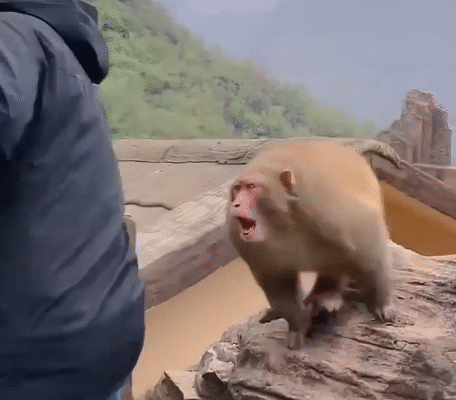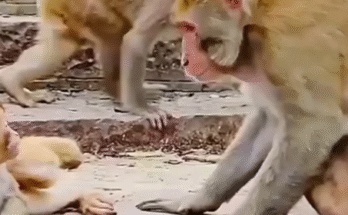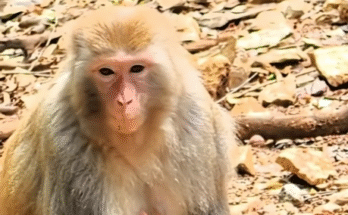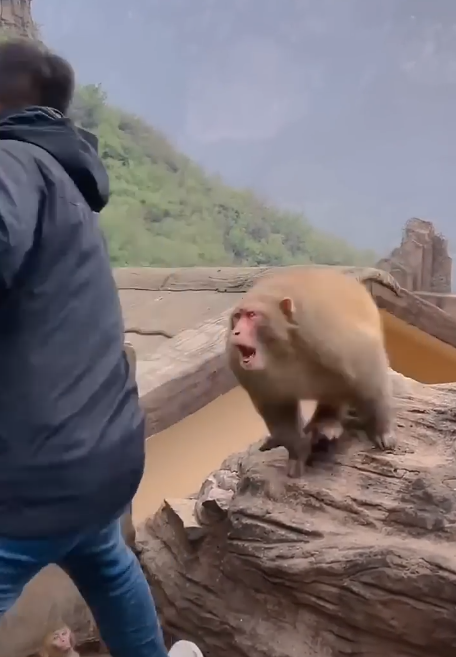
Laughter is one of the few things that transcend species. While humans have their jokes, monkeys have a keen sense of observation, mimicry, and playful intelligence. In the dense jungle or even in human proximity, monkeys are always watching, always learning, and, sometimes, always judging. There’s a special kind of humor in the way a monkey recognizes a human’s antics—a mix of amusement, disbelief, and perhaps a little mischief of its own. This is the story of a monkey who clearly knew the human was fooling around, and how the two unwittingly engaged in a playful, hilarious game of observation, reaction, and mutual entertainment.
The Scene Begins
It was a bright, sunny morning. The kind of day where shadows danced on the ground and the air was alive with the sound of rustling leaves and distant birdcalls. A human—let’s call him Sam—was standing near the edge of a jungle clearing. He had brought with him a bag of bananas, a notebook, and a mischievous plan. Sam liked to joke, to play pranks, and to see reactions. Little did he know, one of the jungle’s most intelligent inhabitants had already spotted him.
Perched on a sturdy branch above, a young monkey watched. Its head tilted slightly, eyes narrowed in curiosity, a small grin forming across its face. The monkey had seen humans before. It had watched them fumble, slip, and fidget. But something about Sam’s exaggerated gestures immediately triggered its amusement sensors.
The First Signs of Fooling Around
Sam began by pretending to trip over a root, sprawling dramatically onto the ground. “Oh no, I’ve fallen!” he exclaimed, flailing his arms in an over-the-top fashion. The monkey blinked, then tilted its head further, clearly unimpressed. Humans, in the monkey’s experience, were prone to clumsiness, but the deliberate nature of Sam’s performance suggested intentional play.
As Sam scrambled to his feet, pretending to stumble again, the monkey couldn’t help but chuckle in its own way—a soft chattering sound that betrayed amusement. Monkeys are highly social and expressive creatures, and this one knew exactly what was happening: the human was not in distress; he was putting on a show.
Testing the Monkey’s Reaction
Feeling emboldened by the monkey’s curious gaze, Sam decided to escalate. He waved a banana in the air, pretending it was a rare treasure. “Look! I’ve found the golden banana!” he exclaimed, twirling it like a trophy.
The monkey, recognizing the exaggeration, slowly crept down the branch closer to him. It paused periodically, sniffing the air, tilting its head, and occasionally glancing at Sam with an expression that could almost be described as judgmental. The human’s antics were transparent, and the monkey’s intelligence allowed it to discern the truth: this was play, not a serious moment.
The Monkey Joins the Game

Humans often think they are the only ones capable of mischief, but monkeys are natural tricksters. Sensing the opportunity for amusement, the monkey decided to participate. It grabbed a small stick, twirled it, and tossed a leaf onto Sam’s head as if to say, “I see your tricks, human, and I approve!”
Sam jumped, pretending to be startled, and the game was on. Each exaggerated movement, each playful gesture, drew a corresponding reaction from the monkey. It became a back-and-forth of observation and mimicry. Sam would act foolish, and the monkey would respond with laughter, gestures, and small tricks of its own.
A Lesson in Observation
What’s remarkable about monkeys is not just their ability to mimic but their acute observational skills. This young monkey was processing every detail: the timing of Sam’s gestures, the exaggeration in his expressions, and the predictability of his play. Every action was analyzed, every reaction stored for future reference.
Monkeys learn through observation. They can tell the difference between genuine and playful human behavior. In this case, the monkey had quickly understood the pattern: exaggerated movements, loud exclamations, and repeated gestures indicated playfulness, not danger. Its responses were calculated, clever, and perfectly timed to maximize amusement.
Escalating Antics
Sam, realizing he was being “watched” and “judged,” decided to up the ante. He pretended to slip again, falling backward into a pile of leaves while letting out a dramatic yelp. The monkey’s eyes widened, then narrowed in what could only be described as a smirk. It hopped onto a lower branch, inches from Sam, as if to say, “Really, human? That’s your act?”
Then, in a playful twist, the monkey grabbed a small stick and lightly tapped Sam’s shoulder. Startled, Sam flailed again, falling into the leaves. The monkey leapt back, chattering with delight, clearly entertained by the human’s theatrics.
This exchange was no longer a simple observation; it had become a genuine game. The human and monkey were now participants in a playful dance of gestures, expressions, and reactions. Each understood the other’s role, and each drew joy from the interaction.
The Joy of Play Across Species
This moment highlighted a profound truth: play and humor are not limited to humans. Monkeys, with their intelligence, social awareness, and curiosity, experience joy in observation and interaction. They recognize exaggeration, deception, and silliness. They respond not out of fear but out of recognition and amusement.
The monkey’s reactions were genuine. Its laughter, gestures, and engagement were signs of understanding and enjoyment. By knowing that Sam was “fooling around,” it demonstrated not only intelligence but emotional awareness.
The Culmination of Antics
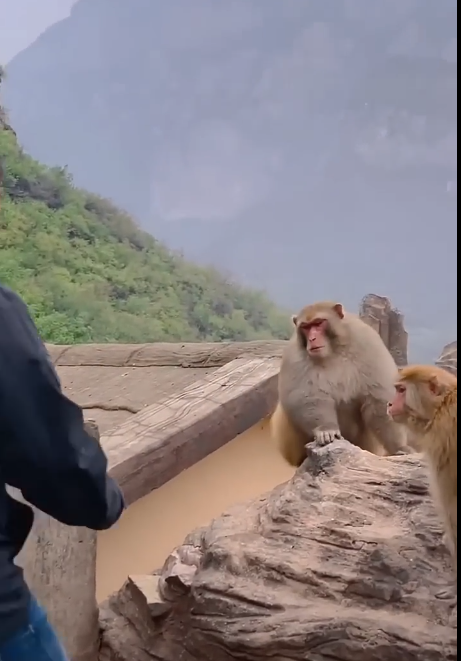
After several minutes of back-and-forth antics, the interaction reached a climax. Sam pretended to faint dramatically, lying flat on the ground with arms and legs spread. The monkey, now fully engaged, crept close, tapped him on the nose, and let out a loud chatter that sounded almost like a scolding.
Sam jumped up, laughing, and the monkey responded by tossing a small leaf in his direction, leaping back into the branches. Both participants had reached a mutual understanding: the human’s fooling around was harmless, entertaining, and a shared experience.
The Aftermath
Eventually, Sam packed up his bananas, smiling at the memory of the playful exchange. The monkey watched carefully until he was out of sight, then returned to its normal routine in the trees. The bond created through this short episode of play would not be forgotten.
For the monkey, the experience reinforced several lessons: humans can be silly, predictable in their patterns, and entertaining. For Sam, it was a reminder that intelligence and humor exist beyond our species. Play is universal, laughter is contagious, and the ability to recognize antics is a sign of awareness and intelligence.
Conclusion
“The monkey knows the human is fooling around 😂😂” perfectly captures this moment of cross-species humor. It was a combination of observation, intelligence, and playful energy that created a shared experience of joy.
Monkeys are not merely observers; they are participants in the dance of life. They understand exaggeration, deception, and play, responding with wit, laughter, and clever reactions. The young monkey in this story demonstrated all of these traits, showing that even in the wild, humor and awareness are alive and vibrant.
This playful encounter reminds us that intelligence, curiosity, and the capacity for joy exist in all creatures. The monkey’s knowing gaze, the careful timing of its responses, and the delightful interaction with the human highlight the universality of play.
In the end, both human and monkey walked away (or leapt away) with a smile in their hearts—a perfect reminder that sometimes, it’s not about who is watching, but who truly understands the joke. And in this case, the monkey knew exactly what was going on, leaving us humans both amused and humbled.
